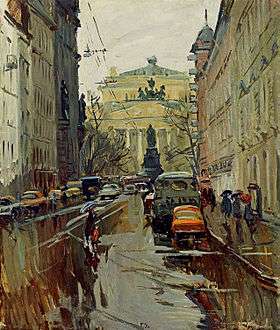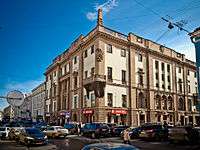Malaya Sadovaya Street
Coordinates: 59°56′6″N 30°20′15.9″E / 59.93500°N 30.337750°E
Malaya Sadovaya Street (Russian: Малая Садовая Улица, meaning "Little Garden Street") is a pedestrian street of cafes, terraces, and fountains[1] in the heart of St. Petersburg. It runs between Italian Street and the Nevsky Prospect. Spanning a single block, at about 175 metres (574 ft) it is known as St. Petersburg's shortest street.[1][2][3]
The street's Nevsky Prospect terminus is at Catherine Square, which features the monument to Catherine the Great by the sculptors Mikhail Mikeshin and Matthew Chizhov and the architects Victor Schröter and David Grimm. At the Italian Street terminus is Manege Square, where there is a view of the portico of the great stables designed by Vincenzo Brenna and Karl Rossi.
History

The street, then called New Lane (Russian: Новым переулком), was first made in the 1740s. A palace belonging to Ivan Shuvalov was built here, completed in 1756, after which the street was called Shuvalov Lane. All the odd side of the street was owned by Shuvalov. His palace was at the corner of Italian Street, after which there was a small fenced garden. From this the street began to be called Little Garden Street from about 1850.[3]
The street was a favored walking venue for Alexander II. In 1873, the street was renamed to Catherine Street in honor of Catherine the Great. It kept this name until the revolution.[3]
In September 1918, a number of streets and squares in Petersburg were renamed, and Catherine Street was renamed Proletkulta Street, after the cultural, educational, and literary organization Proletarian Culture which at the time was housed on the street, at #2. But after World War II, most of these streets were returned to their historical names, and in 1949, Proletkulta Street again became Malaya Sadovaya Street.[3]
Notable buildings
Shuvalov Mansion
The Shuvalov Mansion at #1 Malaya Sadovaya/#25 Italian was designed by the architect Savva Chevakinsky and constructed in 1749 - 1756. From 1802 to 1917 it housed the Ministry of Justice of the Russian Empire. An addition to the middle part of the ministry building was constructed in 1845 - 1849; the initial design was by Fyodor Braun and the project was completed by Dmitry Efimov.
In 1875 through 1927 the jurist Anatoly Koni lived in this building. Later the building housed the Public Health Committee of St. Petersburg and the Museum of Hygiene, which is there today.[4]
Radio House
Across the street, at #2 Malaya Sadovaya/#27 Italian the architect brothers Vasily Kosyakova, Vladimir Kosyakova, and Georgi Kosyakova designed a building for the St. Petersburg Assembly of Nobles, which was constructed in 1912 - 1914.

With the coming of World War I, the Japanese Red Cross set up a hospital in the building for severely wounded soldiers. Japanese doctors, nurses, and pharmacists worked here together with their Russian counterparts, and the staff took pride in the low mortality rate achieved - 6 deaths among the 500 patients admitted. Among the nurses was the wife of the Japanese Ambassador Motono Ichirō. Soon the sprawling hospital took over the whole building, except for the theater hall and several rooms reserved for the Noble Assembly. The Japanese left in April 1916.
In 1918, the organization Proletarian Culture took over the building. During this time, the actor, director, and founder of the Petroproletkulta Theater, Alexander Mgebrov, worked here. In 1930 Proletarian Culture was disbanded and beginning in 1933 the building housed Radio Leningrad. This was active during the heroic days of the siege, and Radio Committee employees lived, worked, and died here. From here they supported the Leningraders with their transmissions, and from here Olga Bergholz, the muse of the embattled city, read her poems and speeches.
On September 7, 1993, the St. Petersburg City Council declared Radio House a monument of historical, cultural, and architectural significance.[5] A plaque to the courage of the workers of Radio Leningrad during the siege now adorns the building entrance.
The studios of Channel 5 are housed there now. The street outside is sometimes used by the station as the site of "man in the street" interviews of passerby.[3]
Demidov House

the Demidov House was built in the 18th Century at the corner of Malaya Sadovaya Street and Nevsky Prospect (#3 Malaya Sadovaya/#54 Nevsky Prospect). In the 19th Century the house underwent two major renovations. The first was in 1841 to a design by Alexander Peltier. Later, the architect Pavel Suzor designed a major reconstruction with new facades, which was undertaken in 1882 - 1883.
Later the building went into the possession of A. Ushokov and became an apartment house. The singer Pauline Viardot-Garcia lived here in 1843, and the photographer Karl Bulla had his studio here. Today the building houses a small museum dedicated to Bulla.
In 2000 the Expert Committee recommended that this building be placed on the list of newly identified sites of historical, scientific, artistic or other cultural value and included in the list of monuments of history and culture.
Armyaninova House
At #4 Malaya Sadovaya Street is the Armyaninova House. Here in 1828 lived the poet Ivan Kozlov, a contemporary of Pushkin.
Elisseevskiy Store

At the corner of Malaya Sadovaya Street and Nevsky Prospect (#8 Malaya Sadovaya/#56 Nevsky Prospect) is the Elisseeff Emporium, designed in the Art Nouveau style by Gabriel Baranowski and constructed 1902–1903.
A restaurant formerly stood at the site.[3] In 1881, revolutionary Narodniks built a tunnel under Malaya Sadovaya Street from the basement of that building, preparing to plant mines to assassinate Czar Alexander II. By March 1 the preparations were complete, but the Czar did not pass that way on that day (and was instead killed by other means).[1][6][3]
Akimov's Comedy Theater is housed in this building.
Conversion to pedestrian street

In 1999 Malaya Sadovaya Street was turned into a pedestrian zone.[3] The street was paved with tiles, the separation between street and sidewalk was removed, benches were added, pipes were laid under the streets carrying heated water to keep the street free of snow and ice,[3] and a fountain featuring a Kugel ball (a heavy stone ball easily rotatable because of lubrication by the fountain's water) was built.
Later, small sculptures were added:
- In 1991, "Dog Gavryusha" by V. A. Sivakov was placed in the courtyard of a house.
- In 2000, two metal cats (named Elisha and Vasilisa) were placed on eaves above the street, at #3 and #8. Petersburgers throw coins at the cats hoping that their wish will be granted if one lands near.[1][7]
- In 2003, a sculpture by B. Petrov was placed, of pioneering photographer Karl Bulla (a former street resident) with a camera and droll bulldog.[1]
References
- 1 2 3 4 5 "The secrets of St. Petersburg's hidden passages". RT (Russia Today). May 20, 2010. Retrieved February 11, 2011. (English)
- ↑ G. Y. Nikitenko. "Malaya Sadovaya Street". Encyclopedia of St. Petersburg. Retrieved February 11, 2011. (Russian)
- 1 2 3 4 5 6 7 8 9 "Малая Садовая улица" [Malaya Sadovaya Street]. Walking St. Petersburg. Retrieved August 24, 2016. (Russian)
- ↑ "St. Petersburg Walking Tour: Nevsky/Sadovaya Axis". National Geographic. Retrieved February 11, 2011. (English)
- ↑ St. Petersburg City Council of People's Deputies (1993). "Decision on September 7, 1993 on the declaration of historical and cultural monuments, urban facilities, and architecture of St. Petersburg". Legislative Assembly of St. Petersburg b. Retrieved February 11, 2011. (Russian)
- ↑ Morfill, William Richard (1913). Readings from The History of Russia - Part IV - The Progress of the Modern Spirit 1855-1913. New York: P.F. Collier & Son. Retrieved February 1, 2010. (English)
- ↑ "Cat Sculptures". Encyclopedia of St. Petersburg. Retrieved February 13, 2011. (Russian)
Further reading
- Alekseeva, Svetlana Vladimirovna (1997). Городские имена сегодня и вчера : справочник-путеводитель : полный свод названий за три века : петербургская топонимика (City names today and yesterday: Guidebook - a complete set of names for three centuries - the St. Petersburg toponymy). Lick. ISBN 5-86038-023-2. (Russian)
- Gorbachevich, Kirill Sergeevich; Evgeniĭ Petrovich Khablo (1998). Почему так названы? (Why is it called that? On the origin of the names of streets, squares, islands, rivers and bridges of St. Petersburg). ISBN 5-7711-0019-6. (Russian)
External links
- Malaya Sadovaya Street article at the Encyclopedia of St. Petersburg (Russian)
- History of Malaya Sadovaya Street buildings at St. Petersburg Assembly (Russian)
- Contemporary photographs of Malaya Sadovaya Street at PetersburgCity
- Photograph of one of the Malaya Sadovaya Street cats
- National Geographic description of area with map (English)
- Map showing Malaya Sadovaya Street at maps.yandex.ru (Russian)
- Leo Marhasev (2003). "Судьба Дома радио (The fate of Radio House)". Neva magazine №9. Retrieved February 11, 2011. (Russian)
